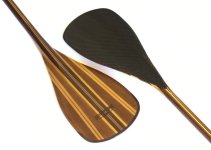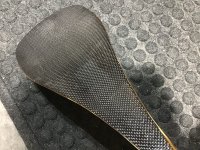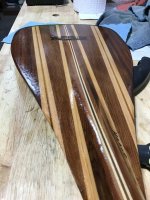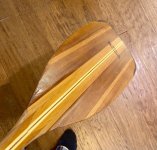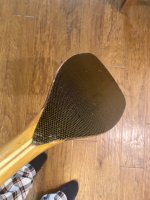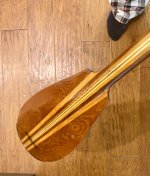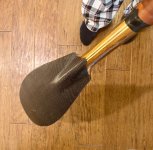Just wondering if anyone has noticed a decline in Sanborn’s attention to detail. I just bought a Nessmuk cedar paddle at Canoecopia. I’ve been wanting one, and the price was right. However, I am not impressed with the quality of the finish on it - and I did ransack through the ones of the length I needed, to try to find the best-looking one. I’ve read about how nice the Sanborn paddles are, and am wondering if a) quality is slipping, or b) they cranked out a pile of paddles for the show really quickly, and this isn’t representative of their usual product. Or c) they brought a bunch of seconds. Or d) they’ve always been like this, and I shouldn’t be so picky.
The paddle itself seems very nice, it’s just the uneven, blotchy finish and slightly rough texture on the blade. And the carbon side isn’t evenly or fully coated - should that be smooth, or should I be able to feel the weave? Maybe an attempt to keep the weight down resulting in an uneven finish? It is 12.6 oz on my kitchen scale. I bought it because the price was better than I could order one and have it shipped for, and I could sand it and put another coat of finish on it myself if need be. I can‘t imagine it will cause any paddling issues. It just isn’t as pretty overall as I had hoped, and the wood underneath clearly is.
The paddle itself seems very nice, it’s just the uneven, blotchy finish and slightly rough texture on the blade. And the carbon side isn’t evenly or fully coated - should that be smooth, or should I be able to feel the weave? Maybe an attempt to keep the weight down resulting in an uneven finish? It is 12.6 oz on my kitchen scale. I bought it because the price was better than I could order one and have it shipped for, and I could sand it and put another coat of finish on it myself if need be. I can‘t imagine it will cause any paddling issues. It just isn’t as pretty overall as I had hoped, and the wood underneath clearly is.

